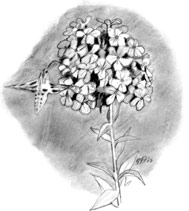|
 |
Earth Journal
by Gary Pendleton |
Hawk Moth on Garden Phlox
Around this time of year, the yard gets a little out of control. Native plants like Joe Pye weed and hibiscus tend to get a little tall. With all the rain they’ve gone wild. The growth is lush and high, and when the wind and storms knock them down, any semblance of order is gone.
But it is a lively and colorful scene. Hummingbirds feed on the intensely red cardinal flower, and goldfinches eat the seeds of the coneflowers, while many types of butterfly sip nectar from flowers. It is not a big yard, but there are opportunities to explore.
There is no rule that any flower planted in our yard must be a native species. The only hard-and-fast gardening rule that I am bound to is No Invasives Allowed. Invasives are plants that, as I understand, harm the environment because they spread aggressively and crowd out native species. Examples of invasive species are purple loostrife, English ivy and, from the animal kingdom, mute swans.
Garden phlox is a native plant with blue or purple flowers that bloom from mid- to late-summer. The name comes from its many characteristics sought after in garden plants. It blooms prodigiously for an extended period. The flowers have attractive shape and color. It is easy to manage and does not try to take over the garden. With good soil and plenty of sun, it reaches nearly two feet tall.
 Garden phlox nicely complements other native flowers such as black-eyed susan and purple coneflower. Another reason to plant garden phlox is its attractiveness to butterflies. Swallowtail butterflies species such as tiger, black and zebra frequently visit. In addition to the butterflies that feed on garden phlox is another fascinating group of insects known as sphinx moths or hawk moths, sometimes called hummingbird moths. Garden phlox nicely complements other native flowers such as black-eyed susan and purple coneflower. Another reason to plant garden phlox is its attractiveness to butterflies. Swallowtail butterflies species such as tiger, black and zebra frequently visit. In addition to the butterflies that feed on garden phlox is another fascinating group of insects known as sphinx moths or hawk moths, sometimes called hummingbird moths.
Hawk moths fly like hummingbirds, and like hummingbirds they hover and feed on flowers by probing for nectar with their long proboscis. At least half a dozen species of sphinx moth can be found in Maryland. They are not exclusively nocturnal, like some other types of moth, so you can look for them during daylight in a sunny garden.
Most species are tan. Closely viewed, some reveal colorful spots and interesting patterns but, because they lack the humming birds’ brilliant colors, they are easy to overlook. However, the careful observer may be rewarded with a sighting. They are likely to be found in any flower garden with healthy populations of bees and butterflies.
Experienced gardeners know the larval forms of certain sphinx moth species as hornworms. Tobacco hornworms and tomato hornworms are large and fearsome looking caterpillars that feed on the leaves of the plants they are named for. They grow to five inches and are boldly patterned with bright green, white and black coloration. The horns, which grow out of their tail ends, look dangerous and give pause to the plant tender who might casually pick them off. Despite their ferocious appearance, they are not dangerous, and Rodale’s Encyclopedia of Organic Gardening says it is okay to pick them off.
This year, because of all the rain and lots of compost, my tomato plants have grown lush and tall as the wild natives. So the plants have leaves to spare. If there are any hawk moths out there, I hope they will join the crowd.
|
